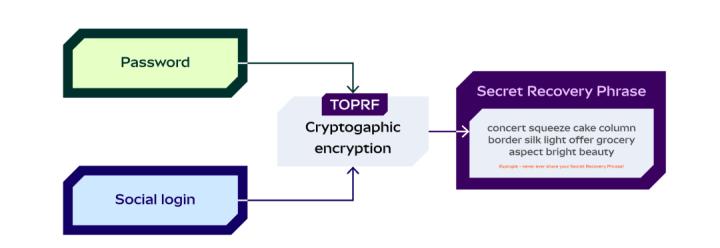Author: chandan
Compiled by: TechFlow
People often compare social media usage to satisfying a sweet tooth, but for most startup founders, building a social presence is a critical task. The platforms we choose not only help us research our audience, drive organic growth, build our brand, but also effectively spread our message - so the need for a social media strategy is obvious. However, developing an effective and realistic plan is not easy.
It seems easy for good creators—a low-quality post can get a million views, a blue dot emoji can spark months of hype—but staying on top of it all is challenging. For one thing, the rules of social media are always changing. Platform X might affect the visibility of posts that link to external sites; Instagram might start prioritizing new types of content; and while we think cryptocurrencies can help in this regard , rule changes often undermine even the most forward-thinking plans.
Algorithms evolve, popular platforms emerge, and new types of viral content emerge all the time. There are always new accounts to create or new experiments to run. So how can a startup with limited resources figure out where to start? And once they get started, how can they tell what’s working? This field is changing rapidly, but there are some practical tips and best practices that apply to any situation.
This post will cover some time-tested guidelines to help startups build a social presence from scratch, including setting goals, identifying target audiences , and measuring success. It will also provide tools and frameworks that founders can use to understand when, how, and what to post, especially when time is limited.
Getting Started: How to Set Realistic Goals
Like any large product project, setting realistic goals before diving in is important to drive momentum and build confidence. Different startups and founders will have different goals, but here are some questions to start thinking about:
What role will social media play? A customer service-oriented social presence will look very different than a founder’s personal account. An account focused on distributing content will require a different approach than one that manages a decentralized community. It’s important to define all of this before you get started.
What’s the end goal? A company might want to build a social following before a project goes public so they have a high-intent audience when they launch. Or, they might want to rebrand. What are you working towards as a founder? How will a social presence support your plans?
What's the timeline? Create short-term goals with specific dates to build momentum. For example, increase your account's followers by 100 in the first month, 200 in the second month, and so on. Be realistic and stick to the plan.
Let these goals form the foundation for all subsequent work. Once the goals are established, the team can move from what they want to achieve to the audience they want to reach.
Identifying your target audience: How to find your target audience
Posting content to new social accounts can feel like shouting into a black hole. Teams must start building an audience early, even if their product hasn’t launched yet.

Before you send your post off into the void, first think about your target audience : Who do you need to reach to achieve the above goals? Are they potential customers, crypto enthusiasts, investors, or someone else entirely?
Many crypto teams often need to prospect for entirely new audiences — especially when launching a first-of-its-kind or experimental product, or are still pursuing product-market fit. That’s OK: target audience isn’t everything, but it’s a useful input to help decide which platforms to prioritize and what type of content to create.
To start focusing, try this six-question framework:
Which accounts are part of your target audience ? Tie this answer into your overall strategy: For example, early-stage crypto startups — even those with broad consumer products — may want to prioritize specific crypto-native audiences. A smarter, more engaged group of early adopters can help startups refine their product roadmaps before a wider launch.
Which social platforms do they use most? If all the conversations a team wants to engage in happen on X, then going all-in on Instagram is obviously a mistake. But the answer to this question isn’t always simple. For example, some highly segmented audiences (including some of the research and academic communities driving crypto innovation) are best reached through email and in-person meetings.
Where in the world is your audience located? This can be tricky with web3 because a lot of people are anonymous, but the more data you can get about where your audience is located, the better. If you learn that half of your audience is in the UK, you probably don’t want to post content while they’re sleeping. Tools like Twitter Analytics can help you get this information. However, a really simple growth hack is to just go into your Discord and invite everyone to show their flag in the chat.
What other accounts does your audience follow? Look at the popular accounts, influencers, and brands your audience follows to get a feel for content type and brand voice. Then consider how your content will look in your followers’ feeds: Will it stand out, or will it fit seamlessly into their information diet? A quick market research can give you a good benchmark for early posts.
What topics do they like to engage with the most? Research accounts that publish high-performing content. Look at their most recent 50 posts to see what works and what doesn’t, then use the best performing topics as inspiration.
How do they use social media? Everyone uses social media differently. Different platforms may have different functions in their users’ lives, whether it’s for entertainment, making connections, or learning new things.
This is just a basic framework. Think of these questions as a map to help you determine where to start. Specifically, which platforms you should start building on and which content types you should start publishing on.
Know where to post: How to prioritize platforms and accounts
Knowing your target audience helps you make several key decisions, especially which platforms and accounts to prioritize.
It’s not uncommon for users to switch between multiple platforms every day. However, for content creators, trying to be present on all platforms at once can seriously affect social strategy. This is especially important for founders because maintaining more than two social platforms at the same time is unsustainable.
The goal is to start small and gradually build your ability to create great content. Later you can expand to more platforms (perhaps by hiring people to help you create and manage content). In the meantime, we usually recommend that founders focus on 1-2 platforms, do them best, and then consider expanding.
For example, founders shouldn’t limit themselves to just brand accounts on LinkedIn and X. It’s also important to consider how their own social media accounts fit into the overall strategy (discussed more below).
Leverage your personal account
Founders often ask us what account they should use to promote their work. Should they invest more time in building their brand on their personal LinkedIn? Or should they create a startup account from scratch?
The answer will depend on their specific goals; however, we’re increasingly finding that founders are advised to leverage their personal accounts for several reasons.
People want to hear a human voice, not a brand voice. Brand accounts often feel like promotional for marketing purposes, while the founder’s voice seems more authentic and not pure marketing.
Personal accounts appear to outperform brand accounts. We also found that on platforms like X, personal accounts outperform brand accounts in terms of engagement and reach, as the algorithms currently favor individual voices.
Building a personal brand can create a product-agnostic audience. No matter which idea a founder is working on or what stage of the product lifecycle they are in, having a strong presence on social platforms can create a built-in audience for future projects, upcoming product launches, or even new social accounts.
Founders don’t need to choose between the two. In fact, operating two accounts allows a company to communicate with its community more effectively (since only a portion of each follower base will see each organic post). More information on founder accounts vs. brand accounts can be found here .
Deciding What to Publish: How to Test Content Types and Find Your Voice
We often hear founders say, “I know I need to have a social media presence, but I’m not sure what to post.”
The goal here is to create social feeds that people want to follow because they offer valuable information and expertise that can’t be found elsewhere — whether it’s an inside look at a popular project , an interesting take on industry dynamics, or niche tips and tricks. In short, great accounts have a unique perspective that sets them apart from the crowd.
So how do you find your perspective? First, we often tell founders to focus on their personal life experiences, interests and obsessions, and their unique expertise. Then, tell stories that educate, inspire, and teach from those perspectives. They can take an objective look at their career, how they spend their free time, the books they love to read, or the creators they follow. Then distill that into a niche.
For more inspiration, there are a few different themes and topics that apply to most companies and are good starting points for adding value:
How-to content (showing people how to do something)
Behind the scenes (giving people a peek into the inner workings of your company)
Industry insights (sharing macro trends that the audience cares about)
Product updates (sharing the product and its new features)
Company announcements (sharing a major achievement, for example)
Community Question (Share a question that the audience may be interested in discussing)
Founder Reflection (share something you’ve learned, recommend a book you’ve read, or share your thoughts on a topic that interests your audience)
The bottom line? Find a niche. Accounts that have a unique perspective and experiment with different content types and formats can add a lot of value.
What happens when the metaverse changes
We’ve all witnessed how changes in social platforms have reshaped how people interact and engage with their content. A recent example is when X began to downrank external links, especially those pointing to Substack . This change forced those promoting their Substack on the platform to rethink their strategies — from burying links to cross-posting entire newsletters on X.
But while change X gets a lot of attention, the reality is that this happens all the time , and social media platforms are constantly trying new ways to keep users on their apps and sites and not go elsewhere. Creators can learn how a particular platform works and optimize content that will rank well, but the rules can change at any time.
Therefore, it becomes increasingly important to stay flexible and willing to try new content types as the landscape changes. While these changes can be painful, they also present an opportunity to think outside the box and test new ways to engage with your followers.
Now that we’ve discussed what to start publishing, let’s talk about how often to publish.
Establish a cadence: how often to release
For those who are new to social media, a common misconception is that the more content you post, the better - if a post doesn't resonate, it's often assumed that the reason is the number of posts the account has published.

This is a common misconception. When it comes to release cadence, the order of importance should be:
Quality > Consistency > Quantity
Focus on quality first, using in-app analytics tools (more on that in the next section) to measure which posts are getting engagement, comments, and shares.
Then think about consistency. You might start by publishing one quality post per month, then gradually increase to two. Look at the data, and if it’s going well, increase your frequency to daily.
A common mistake people make is flooding their feed with posts in the hope of connecting with their audience. The goal is to gradually develop social media skills, including process, taste, timing, etc. - all of which takes time.
A quick start guide to building a rhythm
Don’t rely on inspiration. Creating a backup of evergreen posts — content that resonates no matter when you publish it — can help fill the gap between big product updates and timely posts.
Instead of waking up every day hoping to come up with a good content idea, use a few focused hours and a little creativity to create a solid backup. Here’s how: First, write out as many ideas as you can, then pick a few that you like best. Write them out and schedule them to be published over the next few weeks. To keep the momentum going, make sure to spend about 30 minutes a day interacting with the comments in your feed.
All this upfront work may seem like a huge time investment, so how can teams tell if their efforts are paying off? Let’s take a quick look at the metrics for success…
Measuring Social Media Success: An Introduction to Social Metrics
“Social media success ≠ follower growth
It also includes:
- Driving leads
- Convert customers
- Improve brand sentiment
- Increase email subscribers
- Expand brand influence
- Build relationships with KOLs
- Grow your gated community
- Get product feedback"
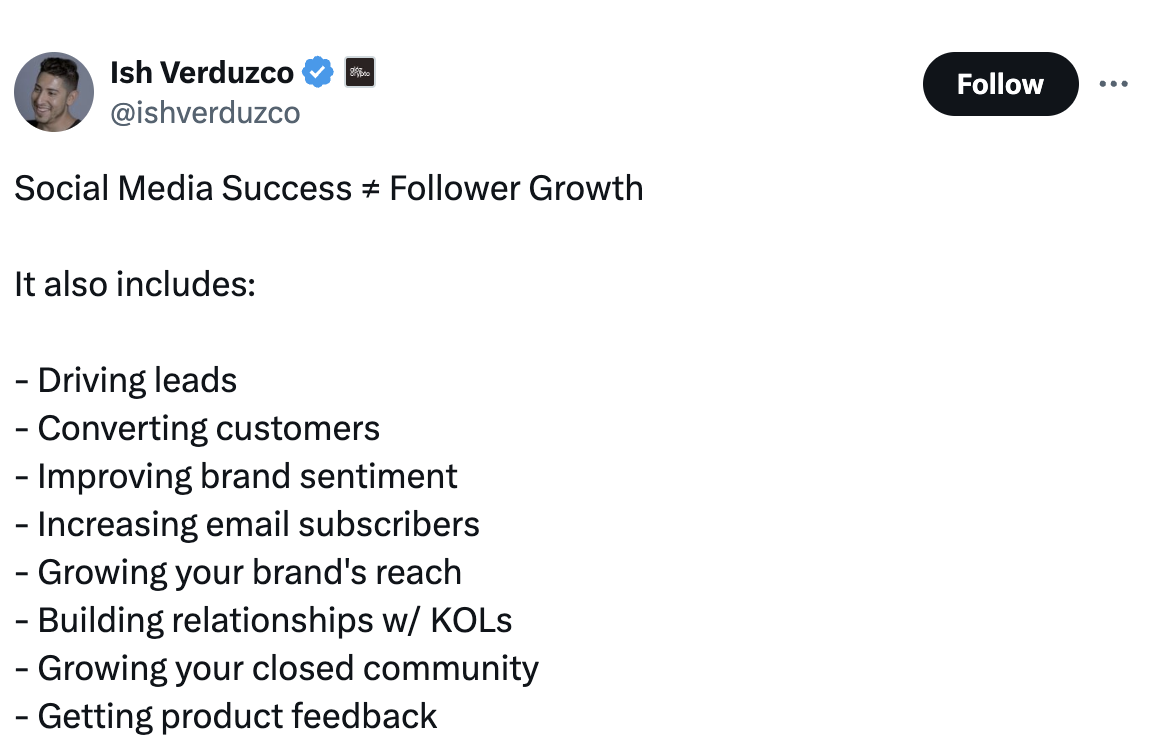
When it comes to measuring the success of your social posts, there are two basic and complementary approaches:
Qualitative : This is a measure of sentiment (how people feel about your company/brand). This includes feedback, replies, and questions, as well as quote tweets, mentions, and direct messages.
Quantitative : This refers to the measurement of growth. This includes interactions, impressions, reach, shares, conversions, followers, and recommendations.
For most founders, the value of quantitative data is obvious — like a set of product metrics, measuring audience growth, shares, and likes are simple. Qualitative feedback, on the other hand, is more difficult to assess; but it is one of the best indicators of how people (and especially which people) are connecting with your brand.
So first, let's look at some very basic quantitative data measures.
Quantitative data
When people are just starting their social strategy, basic tools like in-app analytics tools (Twitter Analytics, LinkedIn Analytics, etc.) will provide all the data they need. Professional tools like Sprout Social and HubSpot can be used for scheduling posts but may be a bit too complex when it comes to advanced analytics. Regardless of what tool a team chooses, here are some key metrics to start with:
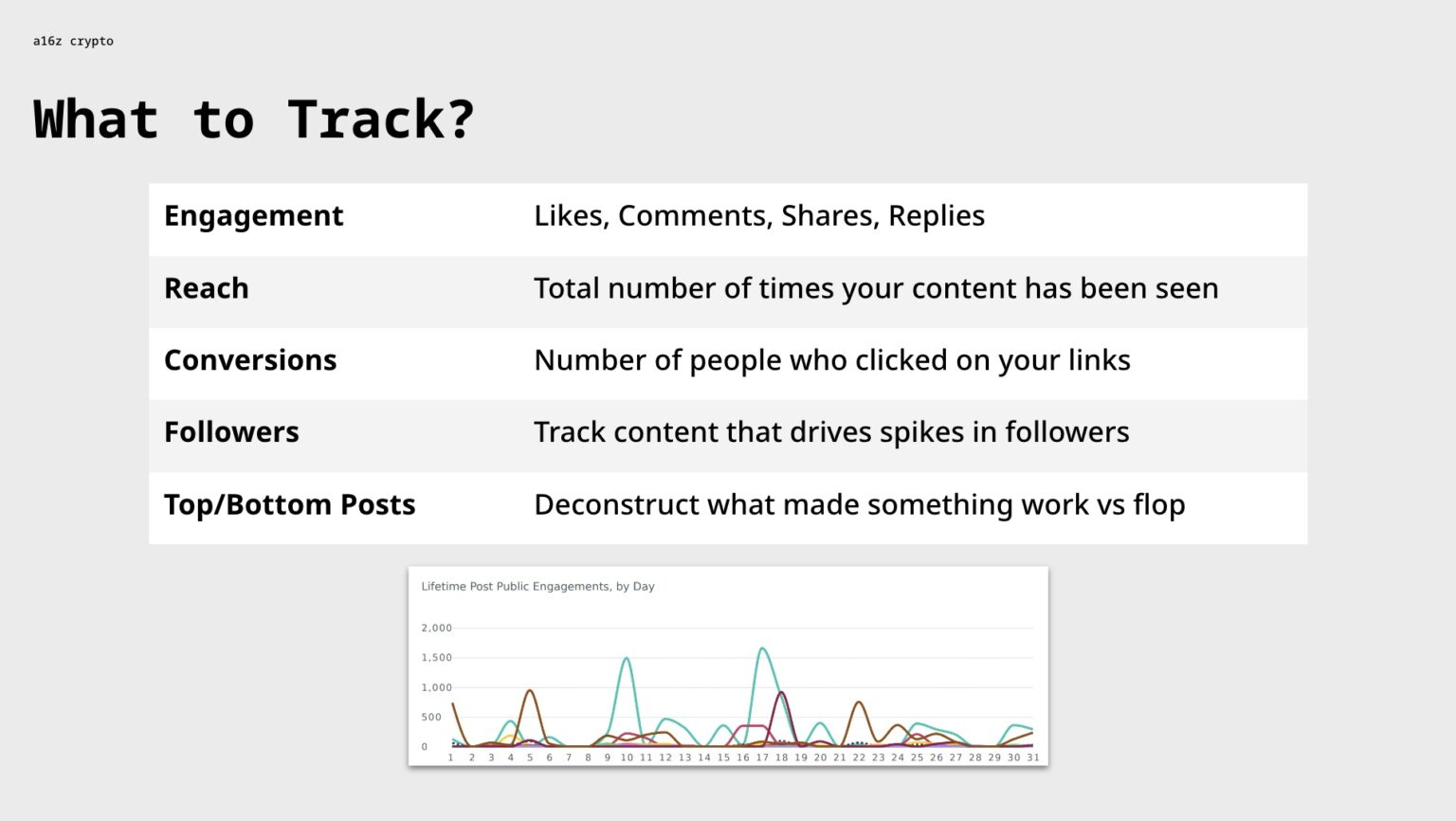
Engagement
Engagement is often the most important qualitative metric you have. Increasing engagement can increase your content's impressions, which is how often users see a piece of content. Increasing impressions can also increase profile visits, increase the number of followers, etc.
Most analytics tools, including in-app analytics, will provide some formula for quantifying engagement, usually expressed as total interactions / total followers or impressions x 100 , but this can vary between platforms. The accuracy of the specific formula is often less important than using a consistent benchmark, and different measurement methods should not be mixed.
One effective way to use in-app analytics tools is to look at your top and bottom performing posts from the last 30 or 60 days, in reverse chronological order, and try to analyze why those posts performed well or poorly.
Your team might find that certain memes perform really well, or that links to blog posts aren’t getting clicks, or that certain topics inspire or inhibit engagement. Tracking this data over time can help you better understand what your audience expects from a particular channel.
It’s also a good idea to track total shares, reactions, reposts, and other metrics on a weekly basis. It’s not necessary to get too granular with the specific numbers, but it’s more important to see the trends over time. For example, if the numbers are consistently rising, that means more people are seeing the account’s content, thus expanding its reach and reaching more potential followers.
Conversion rate
Assuming the team has a product in the market, another key statistic is conversion rate , which is the number of people who click on a social post to go to the product website, newsletter, podcast, etc.
Teams can also use Google Analytics , UTM links , and other tools to track conversions from organic posts (vs. paid ads), from clicks to signups or purchases. But in the early stages, this level of granularity is often a nice-to-have rather than a necessity.
Audience
Understanding what content drives spikes in follower counts is more important than just tracking total follower counts. If a certain type of post reliably grows a specific audience, this is extremely valuable information. As mentioned earlier, it’s also a good idea to track your best and worst performing posts and try to understand what makes a particular post successful or unsuccessful.
Growth in follower count is a good indicator that an account is reaching more people, but it doesn’t provide deep insights into whether the account is reaching the right people. This is where qualitative data comes in handy.
Qualitative Data
Don’t ignore qualitative data. In fact, spending time thinking about qualitative social information can be more helpful than quantitative data, although this mindset is hard for some data-driven founders to accept.
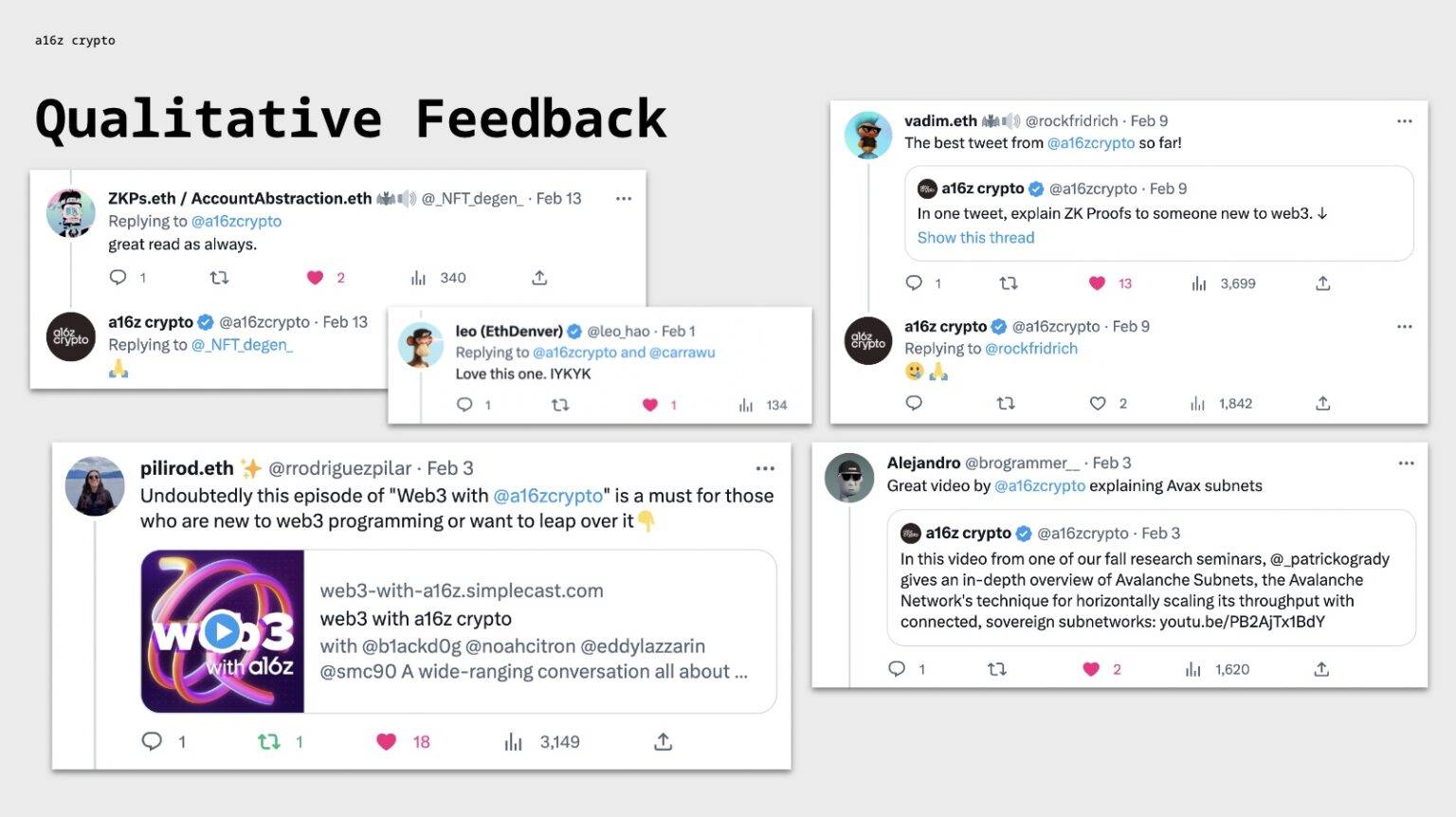
For example, countless businesses rely on the power of “influencers” to spread their message. A share from someone with a wide network and trusted brand is often more influential than hundreds of shares from a small account. Just like reaching higher-quality leads often drives more significant business growth than reaching people who have no demand for your startup’s product. Asking “are we reaching the right people” is just as important (if not more important) when growing followers than simply asking “are we reaching more people.”
The tricky thing about extracting actionable information from qualitative data is that it's more art than science. The best way to do it is manually, at least initially — while there are a lot of different sentiment analysis tools, this type of analysis isn't completely precise. The goal is to extract themes from the messages and direct messages you receive, paying special attention to the words people use and whether those words are positive, negative, or neutral. Then keep track of this information over time.
All of this material helps companies understand how people perceive them — critical information for improving customer service, identifying gaps in product offerings, and even finding product-market fit.
Qualitative vs Quantitative
Every measurement strategy should evaluate performance from multiple perspectives. This is because relying too heavily on one metric can distort your view of how a post is performing. It can also create perverse incentives for your social strategy in the long term. A familiar example is the excessive focus on views and impressions. Posts that get the most views and impressions (clickbait, so to speak) are not necessarily conducive to building a well-liked or trusted brand.
Instead, focus on a more diverse mix of metrics. For new teams, you don’t need to measure everything right away, but you should combine qualitative performance with broader metrics that measure quantity (like impressions) and metrics that measure quality (like engagement and click-through rate). This very basic framework can provide a more accurate picture of post performance.
Challenge of the Silent Supporter
One of the biggest challenges in accurately capturing sentiment is the emergence of “quiet supporters” who read a startup’s content but don’t leave comments or likes. Some people consume a lot of content but don’t interact in the feed for a variety of reasons; for example, to avoid publicly expressing reactions on social platforms like LinkedIn.
Don’t get discouraged by the missing pieces — content creators can try several different approaches to encourage engagement and help round out the overall perception.
Start a conversation: Have conversations with those who engage and don’t engage with your content, asking for feedback to replicate what’s working and discard what’s not.
Host events: Host virtual or in-person events to deepen relationships with your audience (content creators may find that their followers become more openly supportive after attending an event).
Focus on community management: Try to do more outward-facing community management (e.g., interact with 5 different followers per day).
Test different types of posts: Sometimes people are supportive but just not interested in the content format. Try different formats like video vs. photo, short vs. long content, or introduce new ways to interact like polls, questions, and AMAs (Ask Me Anything).
Don’t get discouraged: Social media success comes in many different forms, including leads, email subscribers, brand sentiment, 1:1 relationship building, product feedback loops, etc. Just because you’re not seeing the engagement you’d like, doesn’t mean your social media efforts aren’t having an impact.
As people become inundated with social media, creators need to find different ways to measure their impact (as well as come up with creative ways to keep their audiences engaged).
Understanding the Growth Flywheel
There’s no magic formula that will make a company’s social accounts grow 10x overnight. But over time, a sound social strategy will create a virtuous cycle in which increased engagement leads to greater reach, which leads to more followers, which leads to more engagement, and so on.
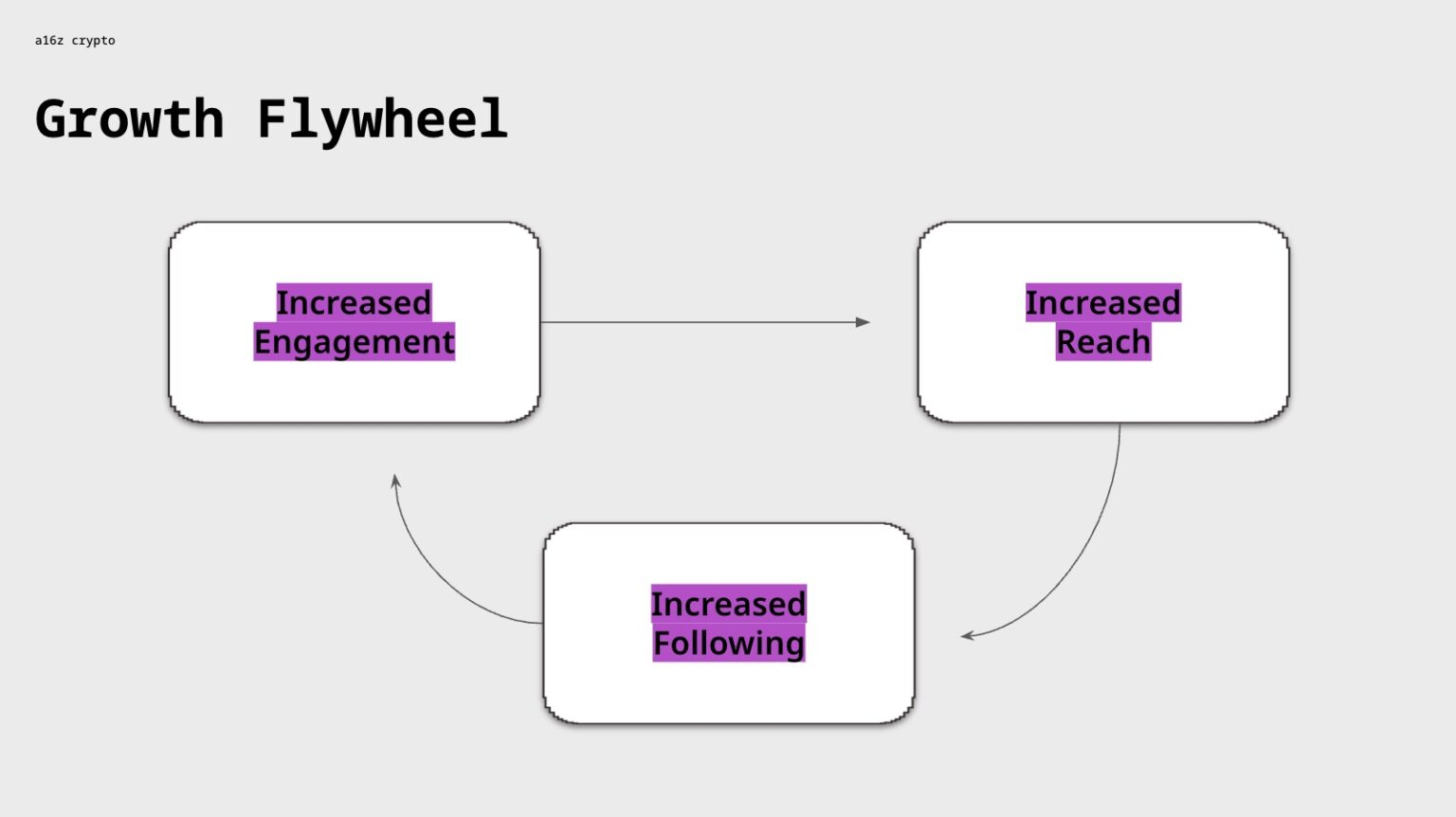
Here are a few ways to speed up this cycle:
Community Management: Publishing content without responding to feedback is a huge missed opportunity for growth. Responding to comments on a post allows it to move up in the feed and get seen by more people. Every time you respond, like, or otherwise interact with a comment, you’re reaching a new audience.
Encourage sharing and replies: Take community management a step further and create posts that are easy to discuss. Ask questions (“What is your favorite crypto meme?”), create curated lists (“10 essential resources on zero-knowledge proofs”), and ask for opinions (“How would you explain web3 to someone who is new to crypto?”).
Maintain a consistent voice: This is why founders create personal accounts that don’t exactly mirror the company account in tone and subject matter. Making them distinct gives people a reason to follow both the founder and company accounts.
Cross-platform promotion: The idea here is to leverage an audience on one platform (like Discord) and get them to follow an account on another platform (like a newsletter). Simple.
Try to avoid links: Because social platforms want to keep their audience on the platform, their algorithms tend to deprioritize posts that contain external links. One way to circumvent this is to post a screenshot of the content you want to share. "Link in profile" is another common circumvention method.
Don’t rely on AI : One of the biggest mistakes we see (on social media) is people completely outsourcing their social presence to AI. Accounts powered by AI lose so much context and personality. For many people, it’s obvious that the account is not run by a human — which can lead to mistrust, lack of engagement, and overall awkwardness.

The bottom line? Be helpful, focus on your niche, and (especially in the beginning) limit yourself to two platforms. Over time, you’ll expand your audience.
Social media can feel like a side hustle for multi-tasking founders. The good news is that starting small is not only good for time management, but also for growth. With some real prioritization, even small teams can build a feed that people want to follow, and maybe even have a little fun with.








